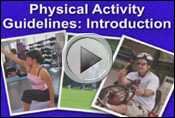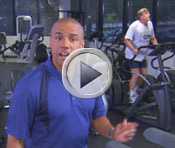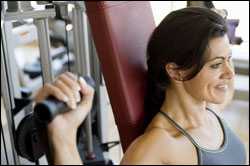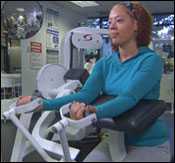How much physical activity do adults need?
Physical activity is anything that gets your body moving. According to the 2008 Physical Activity Guidelines for Americans, you need to do two types of physical activity each week to improve your health–aerobic and muscle-strengthening.
For Important Health Benefits
![]() 2 hours and 30 minutes (150 minutes) of moderate-intensity aerobic activity (i.e., brisk walking) every week and
2 hours and 30 minutes (150 minutes) of moderate-intensity aerobic activity (i.e., brisk walking) every week and
![]() muscle-strengthening activities on 2 or more days a week that work all major muscle groups (legs, hips, back, abdomen, chest, shoulders, and arms).
muscle-strengthening activities on 2 or more days a week that work all major muscle groups (legs, hips, back, abdomen, chest, shoulders, and arms).
![]()
![]() 1 hour and 15 minutes (75 minutes) of vigorous-intensity aerobic activity (i.e., jogging or running) every week and
1 hour and 15 minutes (75 minutes) of vigorous-intensity aerobic activity (i.e., jogging or running) every week and
![]() muscle-strengthening activities on 2 or more days a week that work all major muscle groups (legs, hips, back, abdomen, chest, shoulders, and arms).
muscle-strengthening activities on 2 or more days a week that work all major muscle groups (legs, hips, back, abdomen, chest, shoulders, and arms).
![]()
![]()
![]() An equivalent mix of moderate- and vigorous-intensity aerobic activity and
An equivalent mix of moderate- and vigorous-intensity aerobic activity and
![]() muscle-strengthening activities on 2 or more days a week that work all major muscle groups (legs, hips, back, abdomen, chest, shoulders, and arms).
muscle-strengthening activities on 2 or more days a week that work all major muscle groups (legs, hips, back, abdomen, chest, shoulders, and arms).
Need more help with the guidelines?
Watch this video:

Windows Media Player, 4:43
More videos
10 minutes at a time is fine
We know 150 minutes each week sounds like a lot of time, but it's not. That's 2 hours and 30 minutes, about the same amount of time you might spend watching a movie. The good news is that you can spread your activity out during the week, so you don't have to do it all at once. You can even break it up into smaller chunks of time during the day. It's about what works best for you, as long as you're doing physical activity at a moderate or vigorous effort for at least 10 minutes at a time.
For Even Greater Health Benefits
![]() 5 hours (300 minutes) each week of moderate-intensity aerobic activity and
5 hours (300 minutes) each week of moderate-intensity aerobic activity and
![]() muscle-strengthening activities on 2 or more days a week that work all major muscle groups (legs, hips, back, abdomen, chest, shoulders, and arms).
muscle-strengthening activities on 2 or more days a week that work all major muscle groups (legs, hips, back, abdomen, chest, shoulders, and arms).
![]()
![]() 2 hours and 30 minutes (150 minutes) each week of vigrous-intensity aerobic activity and
2 hours and 30 minutes (150 minutes) each week of vigrous-intensity aerobic activity and
![]() muscle-strengthening activities on 2 or more days a week that work all major muscle groups (legs, hips, back, abdomen, chest, shoulders, and arms).
muscle-strengthening activities on 2 or more days a week that work all major muscle groups (legs, hips, back, abdomen, chest, shoulders, and arms).
![]()
![]()
![]() An equivalent mix of moderate- and vigorous-intensity aerobic activity and
An equivalent mix of moderate- and vigorous-intensity aerobic activity and
muscle-strengthening activities on 2 or more days a week that work all major muscle groups (legs, hips, back, abdomen, chest, shoulders, and arms).
More time equals more health benefits
If you go beyond 300 minutes a week of moderate-intensity activity, or 150 minutes a week of vigorous-intensity activity, you'll gain even more health benefits.
Aerobic activity – what counts?
For more help with what counts as aerobic activity, watch this video:
Windows Media Player, 4:48
Aerobic activity or "cardio" gets you breathing harder and your heart beating faster. From pushing a lawn mower, to taking a dance class, to biking to the store – all types of activities count. As long as you're doing them at a moderate or vigorous intensity for at least 10 minutes at a time.
Intensity is how hard your body is working during aerobic activity.
How do you know if you're doing light, moderate, or vigorous intensity aerobic activities?
For most people, light daily activities such as shopping, cooking, or doing the laundry doesn't count toward the guidelines. Why? Your body isn't working hard enough to get your heart rate up.
Moderate-intensity aerobic activity means you're working hard enough to raise your heart rate and break a sweat. One way to tell is that you'll be able to talk, but not sing the words to your favorite song. Here are some examples of activities that require moderate effort:
- Walking fast
- Doing water aerobics
- Riding a bike on level ground or with few hills
- Playing doubles tennis
- Pushing a lawn mower
Build Up Over Time
If you want to do more vigorous-level activities, slowly replace those that take moderate effort like brisk walking, with more vigorous activities like jogging.
Vigorous-intensity aerobic activity means you're breathing hard and fast, and your heart rate has gone up quite a bit. If you're working at this level, you won't be able to say more than a few words without pausing for a breath. Here are some examples of activities that require vigorous effort:
- Jogging or running
- Swimming laps
- Riding a bike fast or on hills
- Playing singles tennis
- Playing basketball
You can do moderate- or vigorous-intensity aerobic activity, or a mix of the two each week. A rule of thumb is that 1 minute of vigorous-intensity activity is about the same as 2 minutes of moderate-intensity activity.
Some people like to do vigorous types of activity because it gives them about the same health benefits in half the time. If you haven't been very active lately, increase your activity level slowly. You need to feel comfortable doing moderate-intensity activities before you move on to more vigorous ones. The guidelines are about doing physical activity that is right for you.
For more examples, see Measuring Physical Activity.
Muscle-strengthening activities – what counts?
 Besides aerobic activity, you need to do things to strengthen your muscles at least 2 days a week. These activities should work all the major muscle groups of your body (legs, hips, back, chest, abdomen, shoulders, and arms).
Besides aerobic activity, you need to do things to strengthen your muscles at least 2 days a week. These activities should work all the major muscle groups of your body (legs, hips, back, chest, abdomen, shoulders, and arms).
To gain health benefits, muscle-strengthening activities need to be done to the point where it's hard for you to do another repetition without help. A repetition is one complete movement of an activity, like lifting a weight or doing a sit-up. Try to do 8—12 repetitions per activity that count as 1 set. Try to do at least 1 set of muscle-strengthening activities, but to gain even more benefits, do 2 or 3 sets.
More videos
Learn how to strengthen your muscles at home or in the gym
You can do activities that strengthen your muscles on the same or different days that you do aerobic activity, whatever works best. Just keep in mind that muscle-strengthening activities don't count toward your aerobic activity total.
There are many ways you can strengthen your muscles, whether it's at home or the gym. You may want to try the following:
- Lifting weights
- Working with resistance bands
- Doing exercises that use your body weight for resistance (i.e., push ups, sit ups)
- Heavy gardening (i.e., digging, shoveling)
- Yoga
They did it. So can you!
 Alex, age 32 "After a knee injury, I decided I needed to be more active and make a lifestlye change."
Alex, age 32 "After a knee injury, I decided I needed to be more active and make a lifestlye change."
 Demetrise, age 42 "I have started exercising regularly to calm down and reduce stress."
Demetrise, age 42 "I have started exercising regularly to calm down and reduce stress."
 Susan, age 45 "Being active helps me keep up with my kids."
Susan, age 45 "Being active helps me keep up with my kids."
- Page last reviewed: June 4, 2015
- Page last updated: June 4, 2015
- Content source:



 ShareCompartir
ShareCompartir
